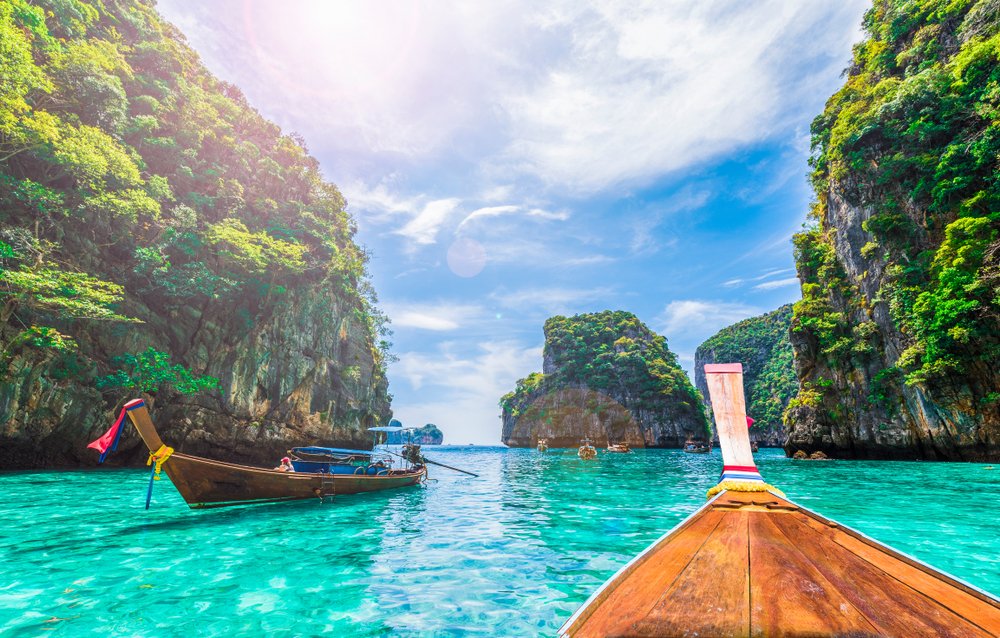
The weather in Thailand:
Thailand is in the tropics, so the weather is warm all year. Different parts of Thailand have different windy seasons. The west coast experiences an unusually big storm in August and September. It’s windy in the north-east from November to April, and in the south-west from May to October. All over, short, light showers happen all the time. In Thailand, the south gets the most rain, the north gets the least, and the middle, which includes Bangkok, is usually the most smokey.
Winter:
It might be best to go to Thailand in December, when it doesn’t rain as much and the days are bright and beautiful. There is rain in the southeast, but the west coast is perfect at this time. On cold nights in the north, you might want to wear a light jacket. (30ºC is normal, and 28ºC is normal for the water.)
January is one of the few cool months in Thailand. In many places, the temperature ranges from the low 20s to the low 30s, with Chiang Mai being the coldest, with a base temperature of 10-15ºC. There isn’t much rain. Everything is full because it’s the busiest time of the year for Christmas in this country. At night, you should wear a light sweater or coat. (The water is usually 28oC.)
Spring:
It stays between 22 and 32oC in February, the same as it did in January. In the south, the chances of rain decreasing, while they rise in the north. The weather is great in the southeast and southwest of Thailand. There is a lot of sunshine and the temperature is in the 20s. (The water is usually 28oC.)
In Thailand, spring comes before summer in March, when temperatures start to rise quickly. Also, shoulder season starts, especially on the islands, so groups start to spread out. The water is actually dry, and it’s a great chance to scuba dive off the west coast. It’s usually between 26 and 31oC, but it can get as hot as 35oC during the day. The water is usually 29oC.
Summer:
Because it is so sticky, it is hot and rough. The south and east coasts might be a little cooler, and the west coast might get a few showers here and there as the storm gets closer. It’s usually between 29 and 34oC, but it can get above 35oC in some places. The water is usually 30oC.
It can get a little cooler in May, but it can still be very rough, and heavy downpours make it much damper. No matter how many bright and sunny days there are, groups are small. The north and east of Thailand are almost always dry. (Usually between 28 and 34ºC, but can get above 35ºC in some places.) (Water is usually 30ºC.)
Monsoon:
The storm brings rain to almost the whole country, and there is a good chance it will pour on the west coast. The weather is usually like May’s. It’s usually between 28 and 34ºC, but it can get above 34ºC in some places. The water is usually 30ºC.
Much more rain falls, and the temperature drops a bit. More showers happen on the west coast than in the east. (The water is normally 29oC and the air is normally 33oC.)
It rains the most in north and west Thailand in August. The east coast, on the other hand, is usually hot and dry. The amount of dampness is really high. (The water is normally 29oC and the air is normally 32oC.)
Fall:
Bad beach conditions can be found all over the country because of heavy rain and rough seas. It’s clear that swarms are rare, and spaces can be rented for a fee. (The water is normally 29oC and the air is normally 32oC.)
It starts to rain less and become less muggy, and northern Thailand starts to feel the cool effects of winter. It’s still hot and sticky in the south. (30ºC is normal, and 29ºC is normal for the water.)
The wettest month is in the eastern islands, like Koh Samui and Koh Pha Ngan. The rest of the country is mostly dry and beautiful. In addition, this is the start of Thailand’s busiest travel season. (30ºC is normal, and 29ºC is normal for the water.)
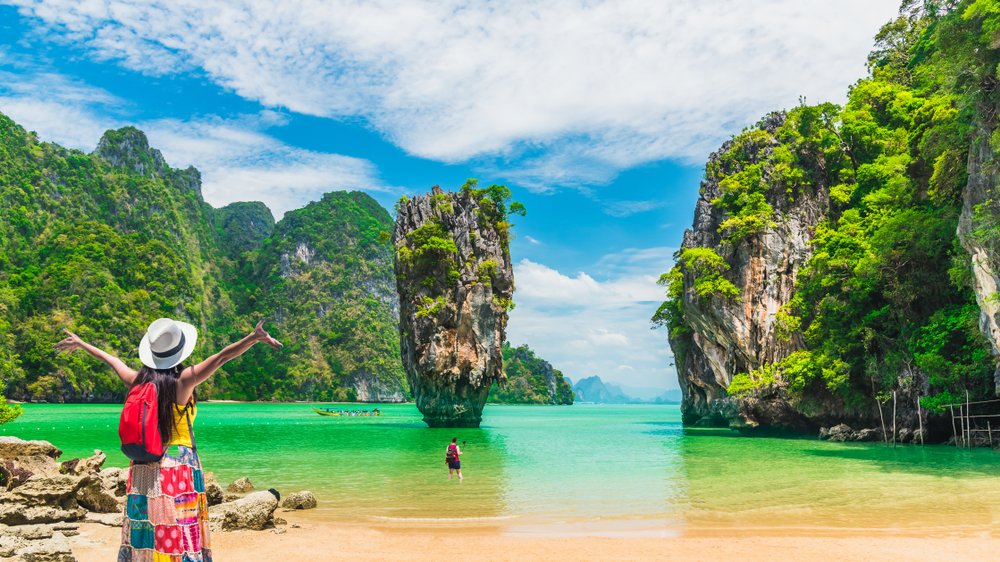
The best time to go to Thailand is:
Late November to early April is the best time to visit Thailand because there isn’t much rain and there is a lot of sun. However, it is cooler during this time. The best months to swim and lay out in the sun on Thailand’s best beaches are from January to April. The best months to visit and travel are December, January, and February. In most of Thailand, the stormy season lasts from July to October.
From November to April:
Thai tourism is at its busiest from late November to early April, especially around Christmas, New Year, and Chinese New Year. That’s when most flights and hotels cost the most. Hotels usually have stricter rules about how long you can stay, what you can bring, and how to leave during these times. To move during the peak season, it’s best to plan and book ahead of time.
October and November:
During the two shoulder seasons, when it’s not too hot and the rain is either starting to fall or ending, Thailand is a great place to visit. Prices are lower, and beaches and tourist spots are not as crowded. Taking a short or long shower every so often will cool you down, but you can’t use water if there is a storm. On the west coast of Thailand, it’s also a great chance to go surfing or bungee jumping.
From May to September:
With temperatures that can reach 45°C, Thailand’s summer is hot and sticky, but it’s also a great time to enjoy the wide range of indoor activities the country has to offer. During the stormy season, it can rain almost every day, and in the middle of the year, the nights can get very bad. The rough weather can also make it harder to dive, surf, and do other water sports. On the other hand, it’s very cheap to go now; bookings should be possible right now, and you can even set up costs at the hotel when you get there. People who want to relax can enjoy a more peaceful vacation on the empty beaches and public sites.
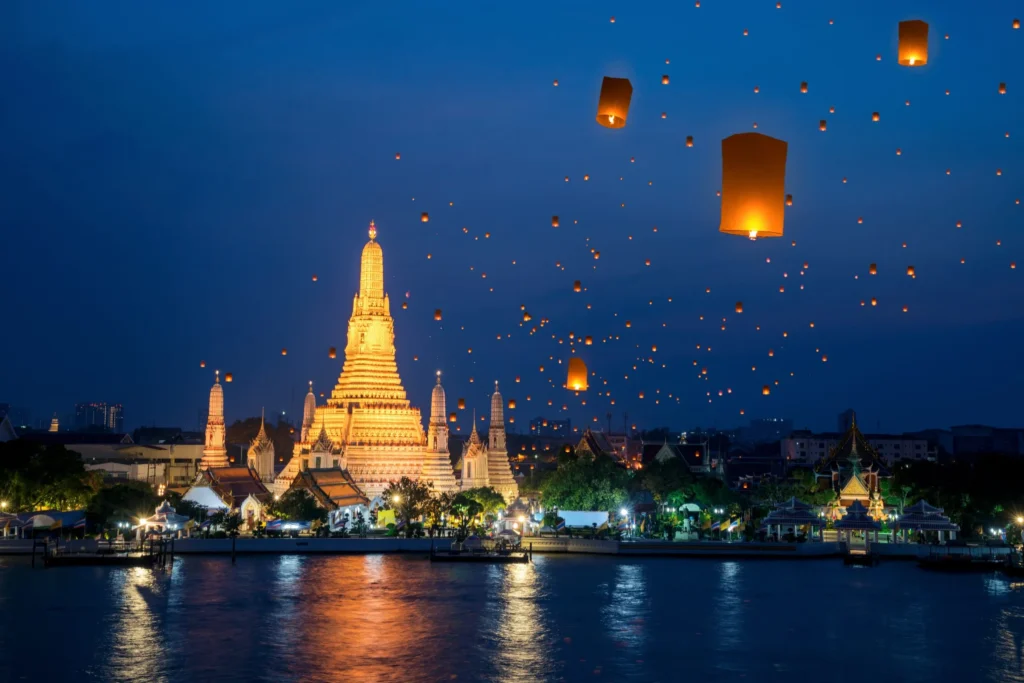
Places we’ve been to in Thailand:
Thailand is full of vivid scenes, such as busy cities with lots of motorbikes and tuk-tuks, peaceful Buddhist sanctuaries staffed by priests in orange robes, hill tribes selling their crafts, opulent scenes with traditional farming towns, old ruins, and shocking coastlines with beautiful beaches and blue tidal ponds.
Sayadaw:
People can wander around the popular but emotional remains of Thailand’s old capital, Ayutthaya, which gives a beautiful view of the country’s beauty. Before Bangkok, Ayutthaya was the most important city in Thailand. The old royal homes and temples are proof of this. A few sights, like the shrine with the 12-meter-long Buddha leaning back and the tree roots holding a Buddha’s head, are truly amazing and should not be missed.
Doi Inthanon:
There are many waterfalls, a nature path, Thailand’s tallest peak (Sakura blooms in January), and the well-known King and Queen pagoda near the top of Doi Inthanon National Park. It’s about a three-hour drive east from Chiang Mai and a beautiful place to spend the day or the night.
The Emerald Lake:
Not many tourists who aren’t Thai think about this sinkhole in the woods that filled up with clear, dark blue water and huge catfish. People in Thailand think of it as holy, and everyone agrees that it’s the only one in Thailand. It’s a little hard to get to, so you should be in a car or a motorcycle with tires that can handle mud and dirt. For those who do make it, they will see something in Thailand that is still a hidden gem.
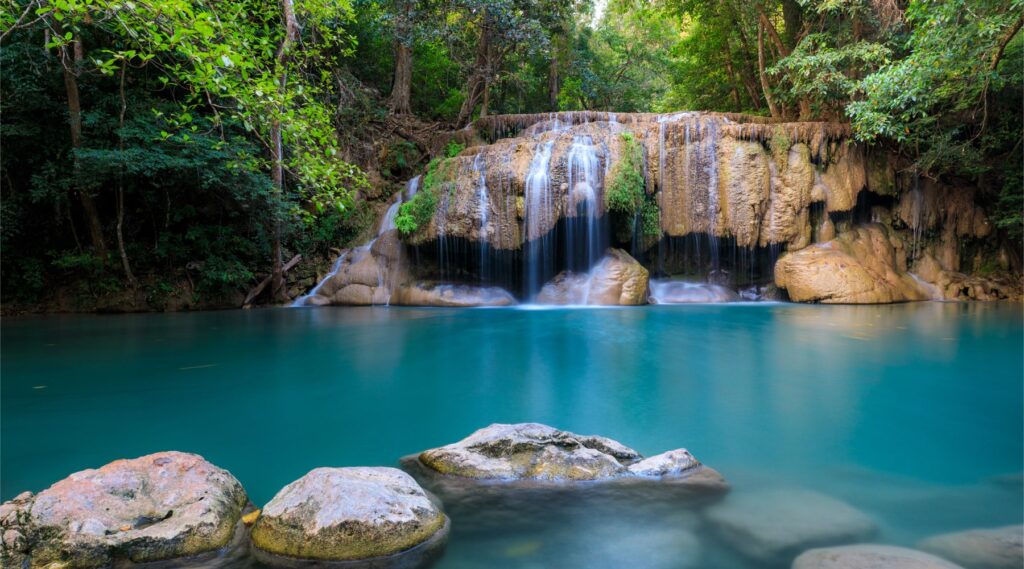
The National Park of Erawan:
People love this public park for the light-colored child blue waterfalls that go down seven floors. It’s also famous for its caves with streams and interesting rock formations.
Mae Hong Son:
The falling piles of the Mae Hong Son area, which borders Myanmar, look like they belong in a fairytale. From Pai, this is a beautiful trip for people who are comfortable driving a car or motorcycle. When you get there, you can go to one of the many nature parks, caves, or underground water sources. Passing through there from Pai is a great way to relax, even if it’s just for a day.
Pai Canyon:
Pai is a heaven for people who don’t follow the rules. It has a market school, a land split that grows everything hibiscus, several beautiful waterfalls, one of which you can even slide down, and some beautiful open land. The most interesting thing about Pai, though, is its gorge, which is made up of sharp orange stone walls that wind around like a maze. As with most of Pai’s best sights, it’s free to enter and easy to get to on a motorcycle.
Pattaya:
Pattaya, Thailand’s self-proclaimed “City of Sin,” might not be for everyone, but it deserves to be on this list because there are so many fun things to see and do there. Most people associate Pattaya with its famous Walking Street and many go-go bars, but there’s a lot to enjoy in the city without going to the more adult areas.
Phuket:
Phuket has many faces. It is Thailand’s largest island and one of the most popular tourist spots in the country. Some first-timers go to the busy beaches of Patong, which is known for its wild nightlife and wide range of water sports. However, there are beaches for everyone. You can take a boat to the beautiful Freedom Beach, relax on Karon Beach, enjoy the views from Kathu Beach, and that’s just the start.
The Silver Temple in Chiang Mai:
Unlike most temples in the area, which are made of gold, the Silver Temple is a beautiful place to visit in Chiang Mai. The outside is complicated, with stories from the Tipitaka and maps of the world’s cities on the walls.
Sukhothai:
People often call Sukhothai, Thailand’s old city, “Thailand’s Angkor Wat.” Even though there is nothing like the real thing, the groups at Sukhothai are much smaller, and the ruins are a sight in their own right. Renting a bike and riding around the old ruins is a great way to spend the day on the way from Bangkok to Chiang Mai.
Islands of Surin:
The Surin islands are a beautiful group of rough islets with an amazing amount of wildness and stunningly blue water. The more well-known Thai islands are known for their sharp karst rock formations. The Surin islands, on the other hand, are known for their compliment shakes and better diving. Even though they’re far away, they’re worth a visit and are often included in liveaboard trips to the Similan Islands.
Tones:
A short long-tail boat ride from Krabi takes you to Tonsai, which is popular with rock climbers, slack-liners, and people who want a more laid-back experience than Railay, which is right next door. Someone who doesn’t want to choose between the two can take a short hike through the forest between Tonsai and Railay. The hike is worth it for the trip to the Railay Lagoon alone.
What’s up?
The pagodas that float in the water in Thailand are probably pretty great. Even though Wat Chaloem is far away and can only be reached by car from Chiang Mai, most tourists who aren’t from there don’t even think about going there. You can take a truck to the top and then walk up the 500 steps to get a breathtaking view of the area, including the white pagodas that were all carried up by hand.
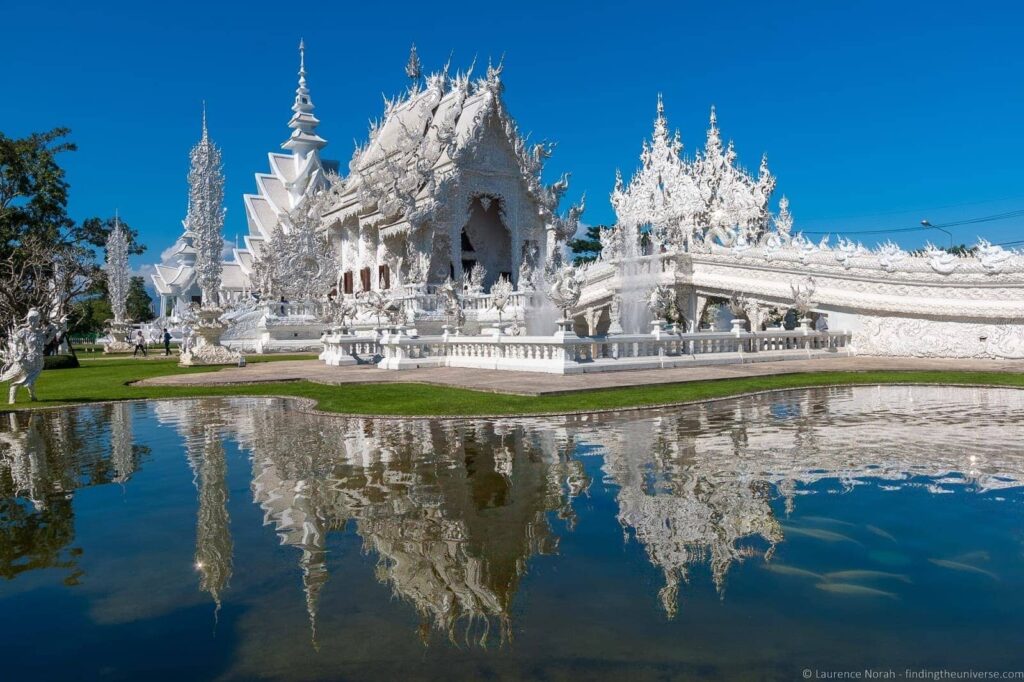
The White Temple in Chiang Rai:
There are many beautiful temples in Thailand, but the White Temple is the most creative. This modern Buddhist temple is unique because of its shape, structures, the beautiful white and silver decorations on the outside, and the strange picture inside.
Thailand’s Unknown Places to Visit:
Thailand has a lot of places that will amaze and charm you if you are the type of traveler who likes to go with the flow. Some of these gems are not hard to get to, while others are hidden in the most remote parts of the country. Of course, all of them lead to meetings that change people’s lives.
Koh Phangan:
There are two sides to the island. Tourists come here during the day to relax and soak up the sun, but when the sun goes down, the island turns into a crazy place. The night parties only happen when the moon is full, and over 30,000 tourists show up in one day! Enjoy the clear blue water or just relax by the beach. But if you come here on a full moon party night, get ready to have a great time with drinks, fun music, and lots of dancing.
Pai:
Pai is a great place for backpackers because it is a small town tucked away in the hills. Enjoy the way the hills are arranged, the lush vegetation, and the beautiful scenery. Pai is the place you should go right away if you want to get away from those crowded city streets for a while. Of course, Pai has some great restaurants and bars, but the best way to really enjoy the town is to check out its natural attractions.
Phetchaburi:
Phetchaburi is a city in central Thailand that is close to the Myanmar border. Tourists haven’t been there in a while, but locals still know a lot about it. Explore its public parks, which have thick jungles with a wide range of amazing wildlife, such as elusive panthers and elephants. You can also find Tham Khao Luang here. It’s an emotional limestone cave with many Buddha statues, including a very large one that is falling back.
Sea of Red Lotus:
When you go to Thailand’s Red Lotus Sea, you’ll see a huge group of lotuses all in one place. There are some unusual places in Thailand where you can see beautiful nature. The Red Lotus Sea is one of them. You can spend a relaxing morning with your family and friends there and explore a hidden gem of Thailand. The peaceful lake is a nice place to get away for a barbecue with lots of lotus flowers.
Sam Phan Bok:
Sam Phan Bok is one of the most beautiful stone projects in Thailand, and you have to go there when it’s windy. You can walk around these volcanic stone formations and see something beautiful in every nook and cranny of the Mae Kong River. They are of normal quality. It really does mean 3000 holes and gives visitors a view that looks like huge mountains in a river.
The Thi Lo Su Waterfall is:
Perhaps the most beautiful limestone falls in Thailand, this one is known to charm you with its thundering sounds and stunning view. When it comes to the total amount of water in the room, Thi Lo Su is likely Thailand’s biggest waterfall. It is right in the middle of the beautiful Umphang Wildlife Safe Haven and is a lovely place to get away from the busyness of life.
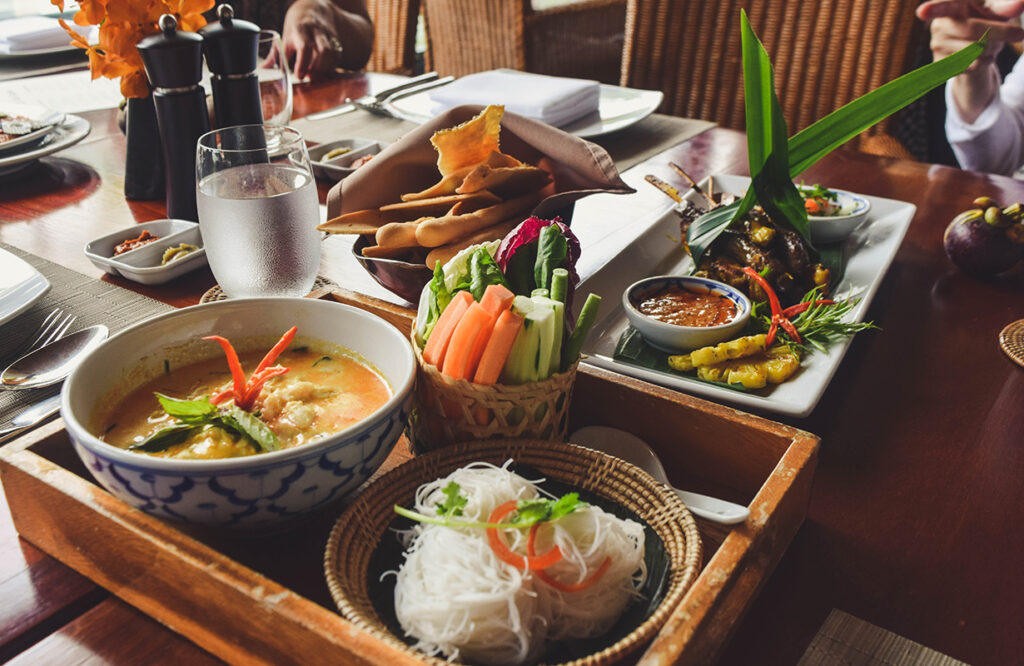
Thai foods and drinks you have to try:
Noodle soup, or Guay Teow:
It looks like guay teow is one of the most famous Thai dishes because you can find it almost everywhere. Any kind of noodle soup is called guay teow. Most of the time, it’s made with chicken, pork, or beef (rarely vegetarian-friendly), and it can be served with rice noodles or egg noodles. Most of the time, sellers also add wontons or meatballs to the stock. You can finish the dish off with a variety of toppings, such as sugar, dried bean stew peppers, lime juice, and fish sauce. You can eat guay teow at any time of the day, but it tastes best as a late-night snack.
Spicy Shrimp Soup, or Tom Yum Goong:
This well-known bowl of steaming goodness is strong, fragrant, and comes with a real hot kick. Things that are very Thai are used to make tom yum goong, such as galangal, onions, lemongrass, stew, new lime juice, and a lot of fish sauce. More prawns and mushrooms are added, along with coconut cream in case you want it to be even smoother.
Tom Kha Gai, which means “chicken in coconut soup,”
Tom kha gai is linked to tom yum and lets people who aren’t very good at savoring new tastes enjoy the same delicious flavors. Besides the level of spice, another interesting thing about Tom kha gai is that it usually comes with a lot of creamy coconut milk, which makes the soup rich and sweet. Like most Thai food, vegan options can be made to fit your needs by switching out a few ingredients.
Thai Som Tam, or Spicy Green Papaya Salad:
You can find som tam in Isaan, which is in the northeast of Thailand. It is probably the most popular dish in Thailand. While there are different kinds of som cap, the traditional one is made with mashed green papaya, tomatoes, carrots, peanuts, dried shrimp, sprinter beans, palm sugar, tamarind mash, fish sauce, lime juice, garlic, and a lot of peppers. Using a mortar and pestle to mix the ingredients makes the tastes stronger, making for a very tasty dish.
Pad Thai (fried noodles in a Thai style):
Pad Thai is a popular dish in Thailand, and tourists who are just starting to learn about Thai food often order it. Fried noodles are used to make pad thai, which is usually made with chicken or shrimp. However, there is a well-known vegan version as well. At almost every traffic light, you can get pad thai, which is a cheap and tasty meal.
Khao Pad (Fried Rice):
Thais love khao pad, which is kind of like how English people love sandwiches. They eat it all at once. Khao pad is short for “seared rice,” which is all it is. It comes with egg, onion, and that’s it. The food usually comes with slices of cucumber to top it off, and a lot of different condiments are added on top so that the buyer can make it taste the way they want.
Panang, or Thai curry:
Panang curry is not as spicy as some of Thailand’s other curry dishes. Because of this, it remains a popular meal among tourists who want to stay in the spicy “safe zone.” Panang curry is usually served with shrimp, but vegetarian options are also popular.
Green Curry, or Gaeng Keow Wan:
From central Thailand, green curry is the spiciest and has just the right amount of sweetness from the extra coconut milk. New green chiles, ginger, eggplant, and, of course, bounty coconut milk are some of the tastiest ingredients used to make green curry. Eat it with a lot of steamed rice to tone down the taste.
What is Kai Jeow (Thai Omelette)?
There are many Thai meals that look hard, but Kai Jeow is one of the easiest. It’s also a great way to get a lot of protein quickly. Most of the time, kai jeow is eaten with rice and sweet bean stew sauce. If you’d like some greens added to your Thai omelet, ask for “kai jeow pak.” If you’re new to Thailand and haven’t tried “jok” (Thai rice soup) for breakfast yet, kai jeow can be a great way to start the day.
Thai Mango Sticky Rice, or Khao Niew Mamuang:
Enjoy a sweet treat at the end of your dinner with this perfect treat! Enjoy tasty mango slices and sticky rice soaked in coconut cream or solidified milk. Just thinking about this Thai treat makes me want it right away. When you try it, you’ll definitely understand what I mean!
Thai iced coffee, or Chai Yen:
Thai espresso that is as dark as 12 o’clock in the afternoon is poured over ice and mixed with thick, sweet, dense milk to make this famous drink that makes you feel like you’re in a dream. It’s incredibly tasty and surprisingly easy to find, which is great because the caffeine, sugar, and general deliciousness make it very easy to become hooked on.
What is Goong Sarong? It’s prawns wrapped in deep-fried noodles.
Usually, I don’t like prawns, but when these little young dogs are wrapped in noodles and cooked on a grill with sweet chili sauce, I should enjoy them. It is usually served as a snack with chicken satay and spring rolls at the table. Be careful not to eat too much or your dinner will go bad.
Pa Pia Sod, or steamed spring rolls:
The Thai Pa Pia Sod’s road version is sure to give you a “spring” in your step! These recently moved canapés come in small pieces with a sauce that goes deep. A sheet of a wheat or rice mixture is rolled up and filled with a crunchy vegetable and thin pieces of meat that have been marinated.
Coconut that is fresh:
We’re so lucky to be able to get close to new coconuts here on the island of Phuket. A lot of them. Some health experts say that coconuts can help your health in a number of ways and are an important part of many Thai recipes. You are doing your body a huge favor when you drink yours, whether you are at Makro or on the go.
Thai Ice Cream Rolled:
Although moved frozen yogurt is a big deal right now, this Instagram-worthy treat was created in the city of Bangkok. Soft, close-packed frozen yogurt is spread out on a very cold metal surface that looks like a business crepe container. Level steel clay blades are then used to cut and spread the yogurt. When you take it out of the fridge, it forms a layer of frozen yogurt that, when scratched, turns into deliciously curled moves. Yeah, it’s a lot of tourists, but it’s also a tasty treat that’s great for cooling off on a hot Thai evening.
Bangkok’s Fruits:
There are natural product leftovers almost everywhere in Thailand. There are beautiful tones and states in these strange natural goods that will catch your attention and make you want to stop and take a moment to enjoy their sweet smells and tasty tastes.
People love Thailand because of its hot, humid weather and fully developed areas. This makes it the perfect place to grow almost any natural product.
Pineapple:
In Thai, mangosteen is called “Mang-Kut” and is known as the “Queen of Fruits.” It is known to “cool” the body, which is different from other well-known Thai organic goods that “warm” the body. When you crack open the rough purple skin, you’ll see 4 to 8 pieces of seeds covered in a white surface that you can eat.
Pineapple:
This tiny, red natural item is about the size of a golf ball and is covered with “Velcro” hairs. When you press it between your hands to let it air out, you can see a seed with a clear, white surface. When you eat the organic product, you bite off the white top of the seed. It tastes sweet, cool, and a little bitter. The Surat Thani area is where the first rambutans were grown in 1926 and is where the best ones are found in Thailand.
Pitaya:
In Thailand, pomelo is called “Som-o.” It is a big, heavy orange fruit that can be as wide as a basketball. The skin is thick and worn, and when you open it, you can see some gathered parts. These are best eaten fresh with salt or spicy dip. They can be sweet or sour.
Dunia:
This is one of the most well-known tropical organic goods in the world, mostly because of its smell, which can be sweet or bad, depending on who you ask. They say that the organic product has a great smell and taste that makes you either love it or hate it. People from the West are especially amazed by how strong the organic product’s scent is; it can be smelled from yards away. Still, Thais love the way the organic product smells and tastes, and the surface is rich and smooth like custard. The Durian, which is called “Turian” in Thailand, is a well-known Spanish fly because it has an amazing ability to raise the temperature inside.
Apple Rose:
In Thailand, Rose Apple is called Chom-Poo. It looks like a small red apple that has been shaped like a ring. It looks like an apple on the outside, but it’s better. People usually eat it raw with salt or mixed in with a hot plate of mixed greens.
The Thai lychee:
This natural product is called “Lihjee” in Thai. It’s bright red and about the size of a golf ball, but it gives people pimples on their skin instead of dimples. That looks like a rambutan without the hairs or a strawberry that is big and dry. When it’s opened, a white surface with a single seed on it is revealed. Lychees are only in season for a few months a year, unless they are canned and used as a popular natural product shake taste.
Thai Banana:
Thai people know the Gluay Hom and Gluay Khai bananas better than any other types. They are available all year and taste best when eaten right away. People often eat fried banana chips and dried banana chips in the evening, and banana leaves are often used to wrap fish or chicken to flame broil.
To Thai Guava:
Thai guava, called “Falang,” tastes best when it’s not fully ripe. Guavas are not common in Thailand; you only see them once in a while. They taste best when eaten raw with salt, and a small amount of them will wake you up and fill you up.
To Thai Mango:
In many Southeast Asian countries, mango is a common food, and in Thailand, it tastes amazingly sweet. When they are not fully ready, they have a strong taste that goes best with salt or other flavors.
The dragon fruit:
The Thai name for this beautiful fruit is “Gao Mung Gorn,” which means “dragonfruit” because its skin looks like the outside of a magical snake. It looks like the long arms of a thorny plant and, when opened, reveals a fuschia-colored surface full of dark seeds. The natural item looks and tastes like a sweet strawberry that hasn’t been sweetened. Bangkok’s best time to visit
Tourists Use TravelJunction To Get To Thailand:
Hack for travelers with a partner:
Just be very polite. A lot of grinning. Send wishes to other people. If the person who works at your hotel recommends a market, bring her something fresh from that market. Doing these small, easy-to-forget things shows people you’re willing to connect and starts conversations. Usually, this is all you need to make a new friend, and it clears the way to make plans.

How to Hack Travelers for Family:
Learn Thai in public. For those who want to learn Thai, especially writing, a well-known cafe is a great place to do it. Read a Thai book or write down words in Thai slang on cheat sheets. If you’re just starting out, buy a book that encourages Thai kids to write, first addressing them by letter and then writing on it yourself (Thais will also find this hilariously cute).
This gives people a normal and easy way to start a conversation, and it also makes you look like a serious traveler trying to immerse yourself in the local culture.
How to Hack Travelers for Friends:
Apps for dating do work. A lot of Thais use dating apps to find love, make friends, or just pass the time. You can definitely use them for what they were made for, but you can also use them to make friends.
Try not to ask anyone to be your neighborhood escort. A lot of awful men you don’t know will send you those messages. In your resume, just say that you’re looking for a friend and that meeting for coffee sounds like the perfect idea. Kindling is well-known and probably all you’ll need.
There are also dating sites that are only for Thai people, but they are known for being for Thai women looking to meet older, foreign guys. Sign up for a tapping app if all you want to do is make some friends.